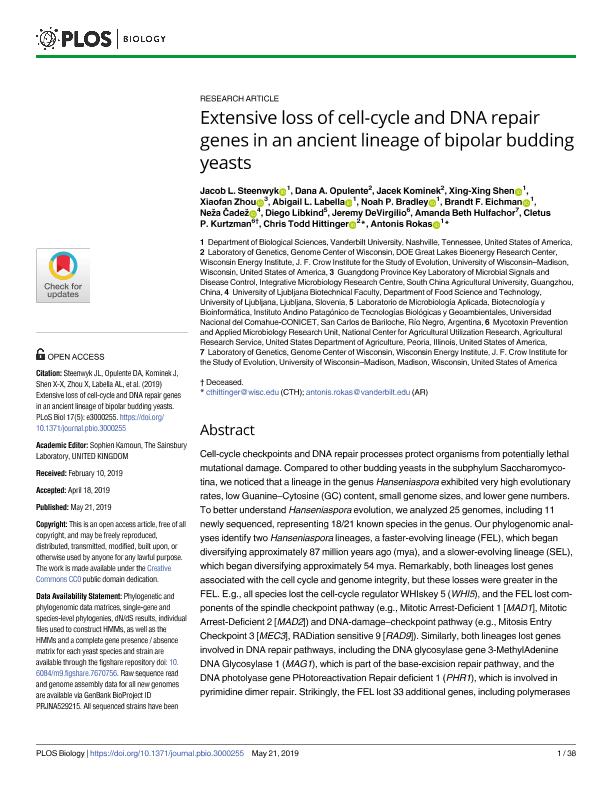Mostrar el registro sencillo del ítem
dc.contributor.author
Steenwyk, Jacob L.
dc.contributor.author
Opulente, Dana A.
dc.contributor.author
Kominek, Jacek
dc.contributor.author
Shen, Xing-Xing
dc.contributor.author
Zhou, Xiaofan
dc.contributor.author
Labella, Abigail L.
dc.contributor.author
Bradley, Noah P.
dc.contributor.author
Eichman, Brandt F.
dc.contributor.author
Cadez, Neza
dc.contributor.author
Libkind Frati, Diego

dc.contributor.author
DeVirgilio, Jeremy
dc.contributor.author
Hulfachor, Amanda Beth
dc.contributor.author
Kurtzman, Cletus P.
dc.contributor.author
Hittinger, Chris Todd
dc.contributor.author
Rokas, Antonis
dc.date.available
2020-12-09T21:36:50Z
dc.date.issued
2019-05
dc.identifier.citation
Steenwyk, Jacob L.; Opulente, Dana A.; Kominek, Jacek; Shen, Xing-Xing; Zhou, Xiaofan; et al.; Extensive loss of cell-cycle and DNA repair genes in an ancient lineage of bipolar budding yeasts; Public Library of Science; PLoS Biology; 17; 5; 5-2019; 1-38
dc.identifier.issn
1544-9173
dc.identifier.uri
http://hdl.handle.net/11336/120071
dc.description.abstract
Cell-cycle checkpoints and DNA repair processes protect organisms from potentially lethal mutational damage. Compared to other budding yeasts in the subphylum Saccharomycotina, we noticed that a lineage in the genus Hanseniaspora exhibited very high evolutionary rates, low Guanine–Cytosine (GC) content, small genome sizes, and lower gene numbers. To better understand Hanseniaspora evolution, we analyzed 25 genomes, including 11 newly sequenced, representing 18/21 known species in the genus. Our phylogenomic analyses identify two Hanseniaspora lineages, a faster-evolving lineage (FEL), which began diversifying approximately 87 million years ago (mya), and a slower-evolving lineage (SEL), which began diversifying approximately 54 mya. Remarkably, both lineages lost genes associated with the cell cycle and genome integrity, but these losses were greater in the FEL. E.g., all species lost the cell-cycle regulator WHIskey 5 (WHI5), and the FEL lost components of the spindle checkpoint pathway (e.g., Mitotic Arrest-Deficient 1 [MAD1], Mitotic Arrest-Deficient 2 [MAD2]) and DNA-damage–checkpoint pathway (e.g., Mitosis Entry Checkpoint 3 [MEC3], RADiation sensitive 9 [RAD9]). Similarly, both lineages lost genes involved in DNA repair pathways, including the DNA glycosylase gene 3-MethylAdenine DNA Glycosylase 1 (MAG1), which is part of the base-excision repair pathway, and the DNA photolyase gene PHotoreactivation Repair deficient 1 (PHR1), which is involved in pyrimidine dimer repair. Strikingly, the FEL lost 33 additional genes, including polymerases (i.e., POLymerase 4 [POL4] and POL32) and telomere-associated genes (e.g., Repressor/ activator site binding protein-Interacting Factor 1 [RIF1], Replication Factor A 3 [RFA3], Cell Division Cycle 13 [CDC13], Pbp1p Binding Protein [PBP2]). Echoing these losses, molecular evolutionary analyses reveal that, compared to the SEL, the FEL stem lineage underwent a burst of accelerated evolution, which resulted in greater mutational loads, homopolymer instabilities, and higher fractions of mutations associated with the common endogenously damaged base, 8-oxoguanine. We conclude that Hanseniaspora is an ancient lineage that has diversified and thrived, despite lacking many otherwise highly conserved cell-cycle and genome integrity genes and pathways, and may represent a novel, to our knowledge, system for studying cellular life without them.
dc.format
application/pdf
dc.language.iso
eng
dc.publisher
Public Library of Science

dc.rights
info:eu-repo/semantics/openAccess
dc.rights.uri
https://creativecommons.org/licenses/by/2.5/ar/
dc.subject
EVOLUTION
dc.subject
FUNGI
dc.subject
YEAST
dc.subject
DNA
dc.subject.classification
Biología Celular, Microbiología

dc.subject.classification
Ciencias Biológicas

dc.subject.classification
CIENCIAS NATURALES Y EXACTAS

dc.title
Extensive loss of cell-cycle and DNA repair genes in an ancient lineage of bipolar budding yeasts
dc.type
info:eu-repo/semantics/article
dc.type
info:ar-repo/semantics/artículo
dc.type
info:eu-repo/semantics/publishedVersion
dc.date.updated
2020-08-05T16:09:20Z
dc.identifier.eissn
1545-7885
dc.journal.volume
17
dc.journal.number
5
dc.journal.pagination
1-38
dc.journal.pais
Estados Unidos

dc.journal.ciudad
San Francisco
dc.description.fil
Fil: Steenwyk, Jacob L.. Vanderbilt University; Estados Unidos
dc.description.fil
Fil: Opulente, Dana A.. University of Wisconsin; Estados Unidos
dc.description.fil
Fil: Kominek, Jacek. University of Wisconsin; Estados Unidos
dc.description.fil
Fil: Shen, Xing-Xing. Vanderbilt University; Estados Unidos
dc.description.fil
Fil: Zhou, Xiaofan. South China Agricultural University; China
dc.description.fil
Fil: Labella, Abigail L.. Vanderbilt University; Estados Unidos
dc.description.fil
Fil: Bradley, Noah P.. Vanderbilt University; Estados Unidos
dc.description.fil
Fil: Eichman, Brandt F.. Vanderbilt University; Estados Unidos
dc.description.fil
Fil: Cadez, Neza. University of Ljubljana; Eslovenia
dc.description.fil
Fil: Libkind Frati, Diego. Universidad Nacional del Comahue. Centro Regional Universitario Bariloche; Argentina
dc.description.fil
Fil: DeVirgilio, Jeremy. United States Department of Agriculture. Agricultural Research Service; Argentina
dc.description.fil
Fil: Hulfachor, Amanda Beth. University of Wisconsin; Estados Unidos
dc.description.fil
Fil: Kurtzman, Cletus P.. United States Department of Agriculture. Agricultural Research Service; Argentina
dc.description.fil
Fil: Hittinger, Chris Todd. University of Wisconsin; Estados Unidos
dc.description.fil
Fil: Rokas, Antonis. Vanderbilt University; Estados Unidos
dc.journal.title
PLoS Biology

dc.relation.alternativeid
info:eu-repo/semantics/altIdentifier/url/https://journals.plos.org/plosbiology/article?id=10.1371/journal.pbio.3000255
dc.relation.alternativeid
info:eu-repo/semantics/altIdentifier/doi/http://dx.doi.org/10.1371/journal.pbio.3000255
Archivos asociados
